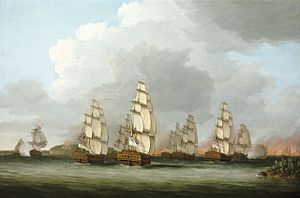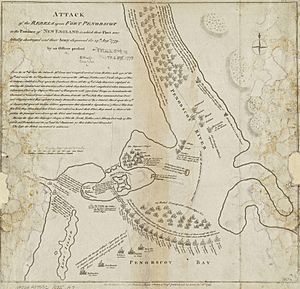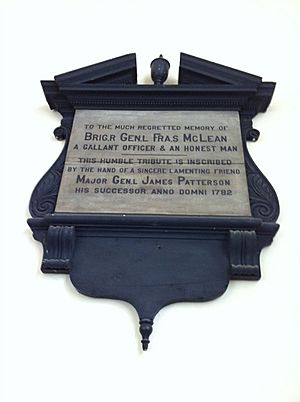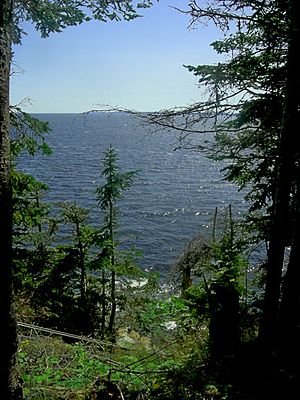Penobscot Expedition facts for kids
Quick facts for kids Penobscot Expedition |
|||||||
|---|---|---|---|---|---|---|---|
| Part of the American Revolutionary War | |||||||
 Destruction of the American Fleet at Penobscot Bay, 14 August 1779, Dominic Serres |
|||||||
|
|||||||
| Belligerents | |||||||
| Commanders and leaders | |||||||
| Strength | |||||||
| 700 10 warships |
3,000 19 warships 25 support ships |
||||||
| Casualties and losses | |||||||
| 86 killed, wounded, captured or missing | 474 killed, wounded, captured or missing 19 warships sunk, destroyed or captured 25 support ships sunk, destroyed or captured |
||||||
The Penobscot Expedition was a huge naval mission during the American Revolutionary War. It involved 44 American ships. The Massachusetts Provincial Congress (a government group in Massachusetts) put this fleet together.
On July 19, 1779, 19 warships and 25 supply ships sailed from Boston. They carried over 1,000 American soldiers and militiamen. A group of 100 artillery soldiers, led by Lt. Colonel Paul Revere, also joined.
The main goal was to take back control of mid-coast Maine. The British had captured this area a month earlier. They called their new territory "New Ireland". This expedition was the largest American naval mission of the war. The fighting lasted three weeks in July and August. It happened on land and at sea near the Penobscot River in Castine, Maine. Sadly, the Penobscot Expedition was the United States' worst naval defeat. It was not topped until the attack on Pearl Harbor in 1941.
On June 17, British soldiers, led by General Francis McLean, landed in the area. They started building forts around Fort George. Their plan was to create a military base and the new colony of New Ireland. In response, Massachusetts quickly put together this expedition. They wanted to drive the British out. The Continental Congress also gave some help.
American troops landed in late July. They tried to surround Fort George. However, there were big disagreements between the American commanders. Brigadier General Solomon Lovell led the land forces. Commodore Dudley Saltonstall was in charge of the ships. This made the attack much harder. General McLean and his British forces held out for almost three weeks. Then, a British relief fleet arrived from New York on August 13. This fleet, led by Sir George Collier, chased the American ships up the Penobscot River. The American fleet was destroyed. The American survivors had to walk back to Massachusetts. They had very little food or weapons.
Contents
Why the Penobscot Expedition Happened
British war planners wanted to control the New England colonies. They had tried before but failed. Now, they focused on the southern colonies. Still, they wanted a base on the coast of Maine. This base would protect Nova Scotia's ships and towns. It would also stop American privateers (private ships acting like warships). The British also needed timber from Maine for their navy ships. The coast near the Penobscot River was also close to Halifax, a big British naval base.
Some British loyalists (people loyal to Britain) in Castine had an idea. They wanted to create a new colony called New Ireland. This new colony would be a safe place for loyalists from New England.
John Nutting, a loyalist, helped the British. He told Lord George Germain, a British official, about the Castine peninsula. Nutting said its harbor was perfect for the British Navy. He also said it would be easy to defend. Germain then ordered General Henry Clinton to set up a base there. However, Nutting's ship was captured by Americans. He had to throw his secret messages overboard. So, the plan for a new colony in 1778 was put on hold.
British Forces Arrive in Maine
John Nutting reached New York in January 1779. General Clinton had already received the orders. Clinton had given the mission to General Francis McLean, who was in Halifax. Clinton sent Nutting to Halifax with the detailed instructions.
McLean's expedition left Halifax on May 30. They arrived in Penobscot Bay on June 12. The next day, McLean and Captain Andrew Barkley found a good spot for a base. On June 16, their forces began landing on a peninsula. This area was called Majabigwaduce, which is now Castine, Maine. It was between the Bagaduce River and the Penobscot River.
About 700 British soldiers landed. They included artillery, engineers, and soldiers from two regiments. They started building a fort on the peninsula. This fort, called Fort George, was in the middle of the peninsula. It controlled the main entrance to the inner harbor. They also built two batteries (gun positions) outside the fort. These batteries would protect the British ship Albany. A third battery was built on an island south of the bay.
The British troops worked on the forts for a month. Then, rumors spread that Americans were planning an attack from Boston. So, the British worked even harder to prepare their defenses. Captain Henry Mowat of the Albany knew about Massachusetts politics. He took the rumors seriously. He convinced General McLean to keep more ships in the area. Some ships had already left, but orders were changed. The armed sloops North and Nautilus stayed.
American Response to the British
When news reached Boston, American leaders quickly made plans. They wanted to drive the British out. The Penobscot River was important. It led to lands controlled by the Penobscot Native Americans. These Native Americans usually supported the British. Congress worried they would lose any chance of getting the Penobscots as allies. This would happen if a British fort was built there. Massachusetts also feared losing its claim to the land after the war.
To lead the expedition, Massachusetts asked Congress for three Continental Navy warships. These were the 12-gun sloop Providence, the 14-gun brig Diligent, and the 32-gun frigate Warren. More than 40 other ships joined. These included ships from the Massachusetts Naval Militia and private ships. Commodore Dudley Saltonstall commanded the entire fleet.
Massachusetts also gathered over 1,000 militia soldiers. They got six small cannons. Brigadier General Solomon Lovell was put in charge of the land forces. The expedition left Boston harbor on July 19. They arrived off Penobscot on the afternoon of July 25.
The Landing and Early Attacks
On July 25, nine larger American ships fired at the British Navy ships. This lasted from 3:30 PM to 7:00 PM. While this was happening, seven American boats tried to land on shore. But they turned back when British fire killed a soldier.
On July 26, General Lovell sent American Continental Marines to capture a British battery. This battery was on Nautilus Island. The militia were supposed to land at Bagaduce. The marines succeeded in their mission. However, the militia turned back. A British cannon shot overturned their lead boat. This killed Major Daniel Littlefield and two of his men. Meanwhile, 750 American soldiers landed under Lovell's command. They began building siege works (trenches and defenses) while under constant fire. On July 27, American cannons fired at the British fleet for three hours. Four men on HMS Albany were wounded.
The Main Assault and Delays
On July 28, a big attack happened. The American ships Tyrannicide, Hunter, and Sky Rocket provided heavy cover fire. Brigadier General Peleg Wadsworth led 400 soldiers ashore before dawn. This force included 200 marines and 200 militia. They landed at Dyce's Head, at the western tip of the peninsula. Their orders were to capture Fort George. They landed on a narrow beach and climbed a steep hill towards the fort.
British guards, including Lieutenant John Moore, fought hard. But they did not get help from the fort. They had to retreat. This left the Americans in control of the high ground. Eight British soldiers were captured. At this point, General Lovell ordered his attackers to stop. He told them to dig in where they were. Instead of attacking the fort directly, Lovell decided to build a battery (gun position). He wanted to bombard the British until they surrendered.
The American soldiers suffered many casualties in this attack. About 100 out of 400 men on the shore were killed or wounded. The Continental Marines had more losses than the militia. Commodore Saltonstall was so shocked by the marine losses that he refused to land any more. He even threatened to call back those already on shore. His main ship, the Warren, was also badly damaged.
Even though the Americans had many more ships than the British, Commodore Saltonstall was very careful. For two weeks, he moved the American fleet around. He stayed out of range of the British guns. He only made a few weak attempts to attack. General Lovell repeatedly asked him to attack the British ships in the harbor. But Saltonstall did not. As long as the British warships controlled the harbor, they could fire on the American land forces. This stopped the Americans from taking Fort George.
On August 11, General Lovell wrote to Saltonstall again. He begged him to attack. He said, "any farther delay must be infamous." He also mentioned a deserter from a British ship who said the British would destroy their own ships if the Americans entered the harbor. Saltonstall's poor leadership at Penobscot later led to his dismissal from the Navy. An investigation found that the expedition failed mainly because Saltonstall lacked "proper Spirit and Energy." They also said he "discouraged any Enterprizes or offensive Measures on the part of our Fleet."
The Siege and British Reinforcements
The siege continued with small fights. On July 29, one American was killed. On July 30, both sides fired cannons at each other all day. On July 31, two American sailors were wounded by a shell. Lovell ordered a night attack on August 1. They aimed for the Half-Moon Battery, which was next to Fort George. Its guns were dangerous to American ships. The Americans opened fire at 2:00 AM.
However, one American column of soldiers broke and ran when the British fired back. Other columns kept going and stormed the battery. As dawn broke, the fort's guns fired on the captured battery. A group of British soldiers charged out and took back the Half-Moon. They defeated the Americans and captured 18 prisoners. The British lost four men killed and 12 wounded.
The siege continued with minor fighting. On August 2, a militiaman named Wheeler Riggs was killed by a cannonball. On August 4, several men were wounded. On August 5, one American was killed and another captured. On August 7, 100 Americans fought 80 British soldiers. One American was killed and one wounded. Two British soldiers were wounded.
During this time, the British had sent messages asking for help. On August 3, Captain (later Vice Admiral) Sir George Collier led a fleet of ten warships from New York.
The next day, Saltonstall finally launched a naval attack against the British fort. But Collier's British relief fleet arrived and attacked the American ships. Two American ships, the privateer "Hampden" and another vessel, were captured. Over the next two days, the American fleet fled upstream on the Penobscot River. Collier's ships chased them.
On August 13, an American officer was wounded. On August 14 and 16, all the American ships were sunk or burned by their own crews. The rest were destroyed near Bangor. Several supply ships were captured or later salvaged by the British. The surviving American crews then walked overland back to Boston. They had almost no food or ammunition.
After the Expedition
A committee investigated why the Americans failed. They blamed the failure on poor teamwork between the land and sea forces. They also blamed Commodore Saltonstall for not fighting the British naval forces. On September 7, Saltonstall was officially charged. He was found guilty and removed from military service. Paul Revere, who led the artillery, was accused of not obeying orders and of being a coward. He was dismissed from the militia, but later cleared of the charges. Peleg Wadsworth, who helped organize the retreat, was not charged.
Some historians, like George Buker, believe Saltonstall was unfairly blamed. Buker argues that Saltonstall was a scapegoat. He says Saltonstall's decisions were actually smart given the situation.
A year later, on August 10, 1780, the British government officially approved the New Ireland project. King George III agreed the next day. The plan was to create a new province called "New Ireland" between the Penobscot and St. Croix rivers. However, after the Peace of Paris in 1783, all British forces left Fort George. About 600 loyalists also left the area. The British gave up on creating New Ireland.
During the War of 1812, British forces again occupied Fort George. They called the area New Ireland from September 1814 to April 1815. They used it as a naval base. Then, they left again when peace arrived. Full ownership of parts of Maine was disputed until the Webster–Ashburton Treaty in 1842. The "District of Maine" was part of Massachusetts until 1820. Then, it became the 23rd state as part of the Missouri Compromise.
Legacy of the Penobscot Expedition
In 1972, the Maine Maritime Academy and the Massachusetts Institute of Technology searched for shipwrecks. They found the wreck of the Defence, a privateer from the American fleet. Evidence of other sunken ships was found under the Joshua Chamberlain Bridge in Bangor. Several items were recovered. Cannonballs were also found during the building of the I-395 bridge in 1986.
The earthworks (old defensive walls made of earth) of Fort George still stand in Castine. Americans added concrete work to them in the 1800s. Archaeologists found evidence of the expedition in 2000–2001. This included cannonballs and cannons.
Since 2004, the Castine Historical Society has a detailed exhibit about the Penobscot Expedition. It is located on School Street in Castine.
In 2021, the San Francisco Unified School District decided to remove Paul Revere's name from a school. They mistakenly believed the Penobscot Expedition was to steal land from the Penobscot people.
In Popular Culture
Bernard Cornwell's 2010 historical novel The Fort tells the story of the expedition. It mentions that a young British officer named John Moore was there. He later became a famous general.






